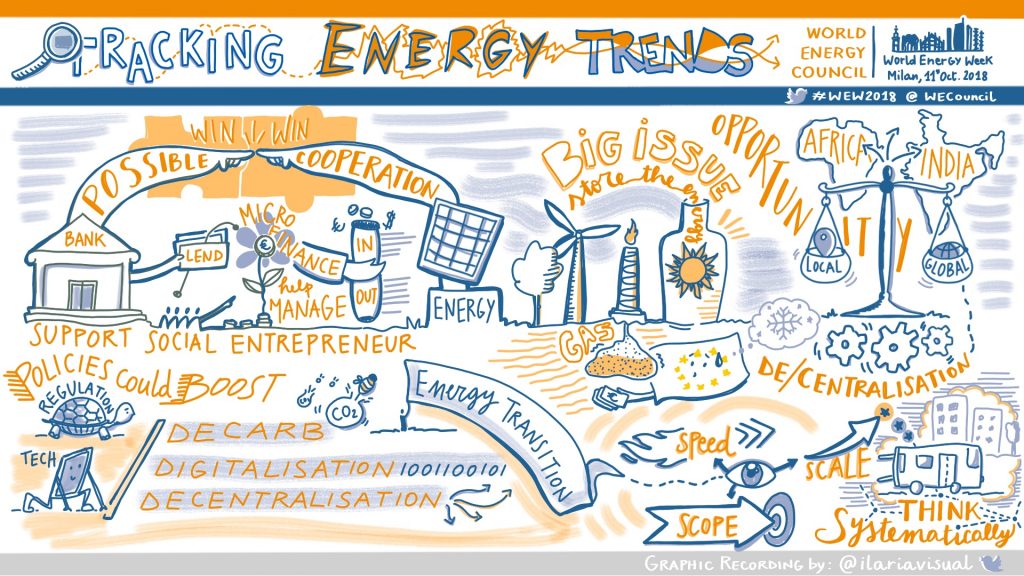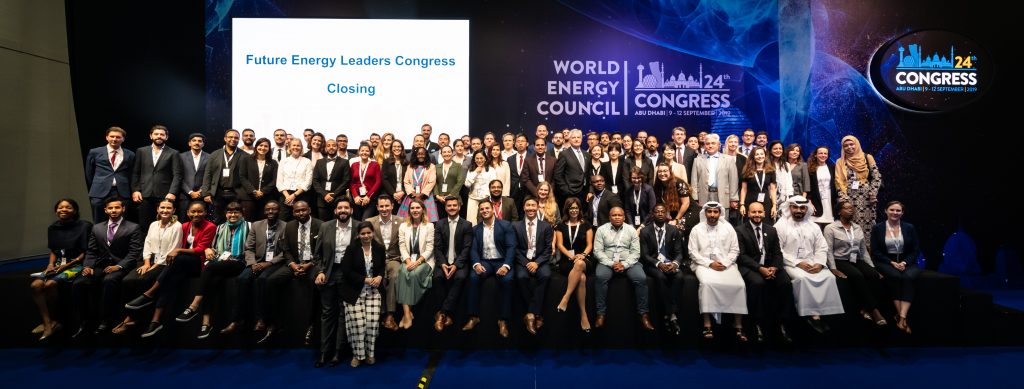Article by Dieyo Moya, Michelle Arellano and Pablo Carvajal
The recent 24th World Energy Congress (WEC24) organised by the World Energy Council in Abu Dhabi (9 – 12 September 2019) was a platform to discuss the key implications for the energy sector to tackle global challenges in a fast-changing landscape of disruptive innovation. World energy leaders from over 40 countries got together to address the complex challenges and opportunities facing the energy transition.
Energy Systems Modelling PhD student Diego Moya, in collaboration with Michelle Arellano – Members Services at the World Energy Council, and Pablo Carvajal – Associate Programme Officer at the International Renewable Energy Agency, IRENA, reflect on the key takeaways from WEC24. Together with other Ecuadorian researchers, they created the Institute for Applied Sustainability Research (IIASUR|). IIASUR is a research institution that brings together researchers interested in Ecuador, Latin America and the Global South to collaborate and unite efforts towards high-end research that can foster sustainable development.

Oil, natural gas and markets
The intake of natural gas into the energy market is gathering momentum with the potential to disrupt the oil and gas markets in the medium term. During the congress political and business leaders discussed long-term strategies to achieve net zero carbon emissions in an inclusive energy prosperity scenario. There was a clear message from global stakeholders that natural gas is going to be a transition fuel, a long-term peak contributor and the bridge between a dirtier-based energy mix and a clean world. The recent discovery of a natural gas field in Saudi Arabia, and the emergence of Egypt as a major gas producer along with the USA, Russia and Iran, has resulted in proven reserves dramatically reducing the cost of natural and improved energy security across regions.
However, a provocative question was the focus of the congress: do today’s policy and market frameworks enable the shifting role of natural gas and what does this mean for existing gas infrastructure?
Natural gas will account for a third of future electricity demand while up to 30% of coal capacity will be retired. Approximately USD 700-800 billion per year will be required to meet the demand of natural gas. This massive investment would involve the implementation of new supporting policies that will disrupt established market structures. Here, a new frontier for innovation is waiting ahead, especially to face infrastructure and market challenges. The dramatic intake of natural gas in the global market will be challenging the economics of oil and will soon require policy, economic and social reforms in major oil-holding countries.

Renewables, innovation, nuclear and hydrogen
Fringe events led by a series of global agencies and initiatives gave delegates the opportunity to deep dive into key technologies and topics inherent to the energy transition. Notably, the discussion centred on the fact that at the core of decarbonisation is the massive deployment of renewable energy, namely solar and wind, however higher penetration of these intermittent energy sources will require the support of other technologies to bring flexibility to the system and to provide alternatives to make the most out of the transition.
In an event led by the International Renewable Energy Agency (IRENA) it was stressed that continuously falling capital costs of renewables make them the cheapest source for generating electricity in many countries, and the falling trend will make this a reality soon across the globe. Solar photovoltaic and onshore wind now compete with traditional power generation sources head-to-head without any subsides.
The role of nuclear energy was also discussed in a fringe event led by the U.S. National Renewable Energy Laboratory and the Clean Energy Ministerial. Nuclear energy remains a strong candidate for a low–carbon power sector, but its high capacity factors and base–load operation pose a challenge for coupling with intermittent renewables. Modularity and small modular nuclear reactors appear to be the way forward for this controversial technology.
Ultimately, beyond the realm of power generation and into the whole energy system transformation perspective, the hydrogen–hype discussion was very much present in a fringe event led by the European Union and Gulf Cooperation Council Clean Energy Technology Network and Hydrogen Europe. In the ongoing energy transition, renewable electricity takes centre stage and electrification is one of the transition’s meta-trends. However, 80% of the total final energy demand by end-users today is from carbon-containing fuels (coal and petroleum liquids), not electricity. Hydrogen producing technology is ready to source energy applications in which electrification has limitations, but capital cost and the transition of gas grids to hydrogen ones appear to be the issues constraining its deployment.
Future energy leaders: stakeholders, youth, next engagements and steps
One of the most exciting energy communities present at the 24th World Energy Congress was the Future Energy Leaders group, who are part of an official programme run by the World Energy Council. Running in parallel to the main Congress, more than a hundred young energy professionals gathered in Abu Dhabi to discuss and debate the most pressing issues on the energy agenda, while also declaring their vision for the future.

Their main pledge was to work towards accelerating the energy transition – and going so far as rebranding the transition as a “revolution”. The Future Energy Leaders also pressed for net-zero carbon emissions and getting there as soon as possible by aiming to exceed the commitments of the Paris Agreement. To achieve this, industry and governments must show leadership by delivering on their respective promises and obligations collaboratively.
The message was also highlighted during the CNN documentary series “The Global Energy Challenge”, where the Future Energy Leaders urged for collaboration, transparency and respect for each other. They noted that the efforts to tackle climate change should not only come from the perspective of early adopters of renewable technology, but it is also identifying potential losers of the transition, so we can support them in mitigating the impact.
Moreover, through a series of challenges, which included mentoring senior executives and playing out decarbonisation scenarios, the Future Energy Leaders were able to experience first-hand what is like to work towards net-zero carbon emissions. This was especially true while role playing in a mock global climate change negotiation. Supported by the MIT Climate Interactive simulation, the Future Energy Leaders got involved as some of the big players in the sector (Governments, Conventionals, RES, Climate Advocates, Industry, Agroforestry) to commit towards a 2°C scenario. While at the beginning most groups where preaching for a carbon tax, in reality, it was clear that international collaboration across the whole value chain was needed, as well as tough compromises to achieve a scenario more ambitious than the Paris pledges.
Diego Moya works as PhD researcher in the MUSE energy system model Group at Imperial College’s Sustainable Gas Institute and is part of the Science and Solutions for a Changing Planet DTP at the Grantham Institute. He is sponsored by the SENESCYT Universities of Excellence Scholarship Scheme and is a scholar of the Faculty of Civil and Mechanical Engineering, Technical University of Ambato, UTA-Ecuador. At Imperial, his current area of research is based on GIS and Agent-based approaches to assess global decarbonisation pathways of the residential sector.
Pablo Carvajal works at the Innovation and Technology Centre of the International Renewable Energy Agency (IRENA). He leads IRENA’s Long-term Energy Ccenario Network, a platform aimed to promote the exchange in the use and development of model-based energy scenarios. Pablo is a Lead Author of the Energy Transitions Chapter of the United Nations Environment Emissions Gap Report 2019. He has lectured on Advanced Energy System Modelling and Microeconomics. His research is focused on energy system models as a tool to guide the clean energy transition. He has been a consultant for the Inter-American Development Bank (IDB), German Technical Cooperation (GIZ) and World Wildlife Fund (WWF). He holds a PhD in Energy & Economics from University College London (UK), a MSc in Renewable Energy from the University of Oldenburg (Germany) and a BSc in Mechanical Engineering from the National Polytechnic School (Ecuador). He is fluent in German, English, Portuguese and Spanish.
Michelle Arellano is Manager of Member Services at the World Energy Council. She acts as first-line of contact and provides support in the development and strengthening of member committees and Future Energy Leaders (FEL-100). She is also the liaison for the member committees in their interactions with the London Secretariat and works with the Regional Managers to support the Council’s network.